Abstract
Direct gene transfer offers the potential to introduce DNA encoding therapeutic proteins to treat human disease. Previously, gene transfer in humans has been achieved by a cell-mediated ex vivo approach in which cells from the blood or tissue of patients are genetically modified in the laboratory and subsequently returned to the patient. To determine the feasibility and safety of directly transferring genes into humans, a clinical study was performed. The gene encoding a foreign major histocompatibility complex protein, HLA-B7, was introduced into HLA-B7-negative patients with advanced melanoma by injection of DNA-liposome complexes in an effort to demonstrate gene transfer, document recombinant gene expression, and determine the safety and potential toxicity of this therapy. Six courses of treatment were completed without complications in five HLA-B7-negative patients with stage IV melanoma. Plasmid DNA was detected within biopsies of treated tumor nodules 3-7 days after injection but was not found in the serum at any time by using the polymerase chain reaction. Recombinant HLA-B7 protein was demonstrated in tumor biopsy tissue in all five patients by immunochemistry, and immune responses to HLA-B7 and autologous tumors could be detected. No antibodies to DNA were detected in any patient. One patient demonstrated regression of injected nodules on two independent treatments, which was accompanied by regression at distant sites. These studies demonstrate the feasibility, safety, and therapeutic potential of direct gene transfer in humans.
Full text
PDF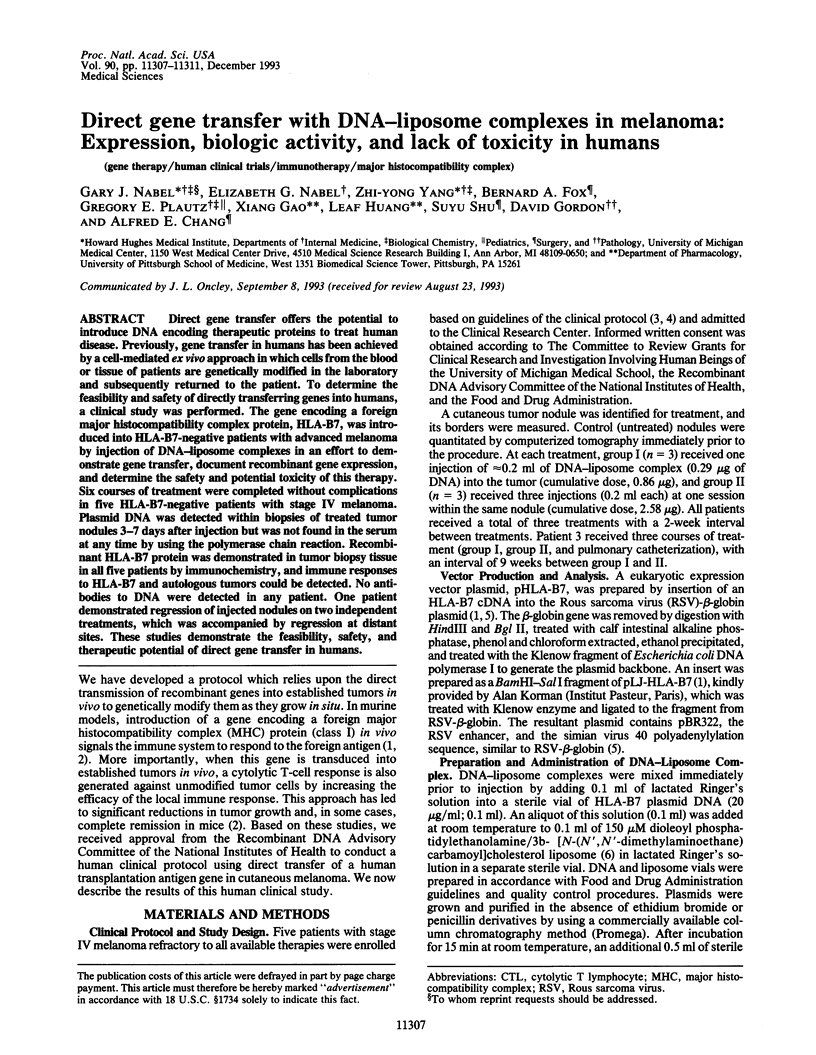
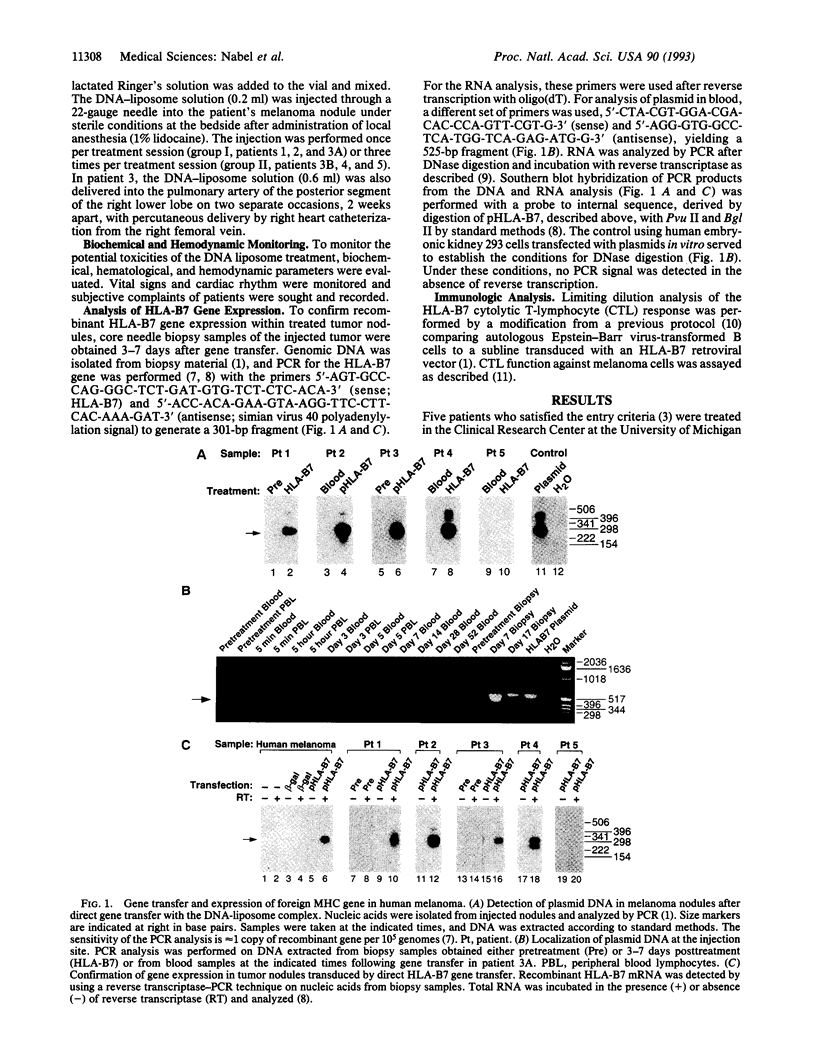
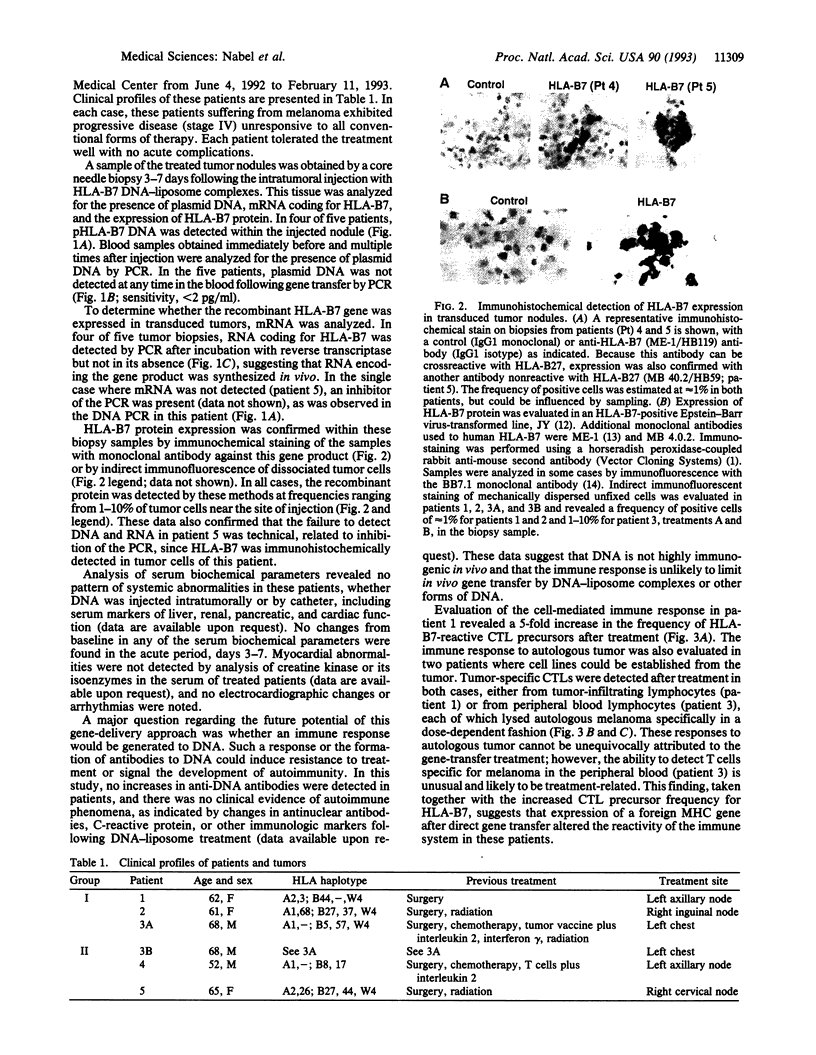
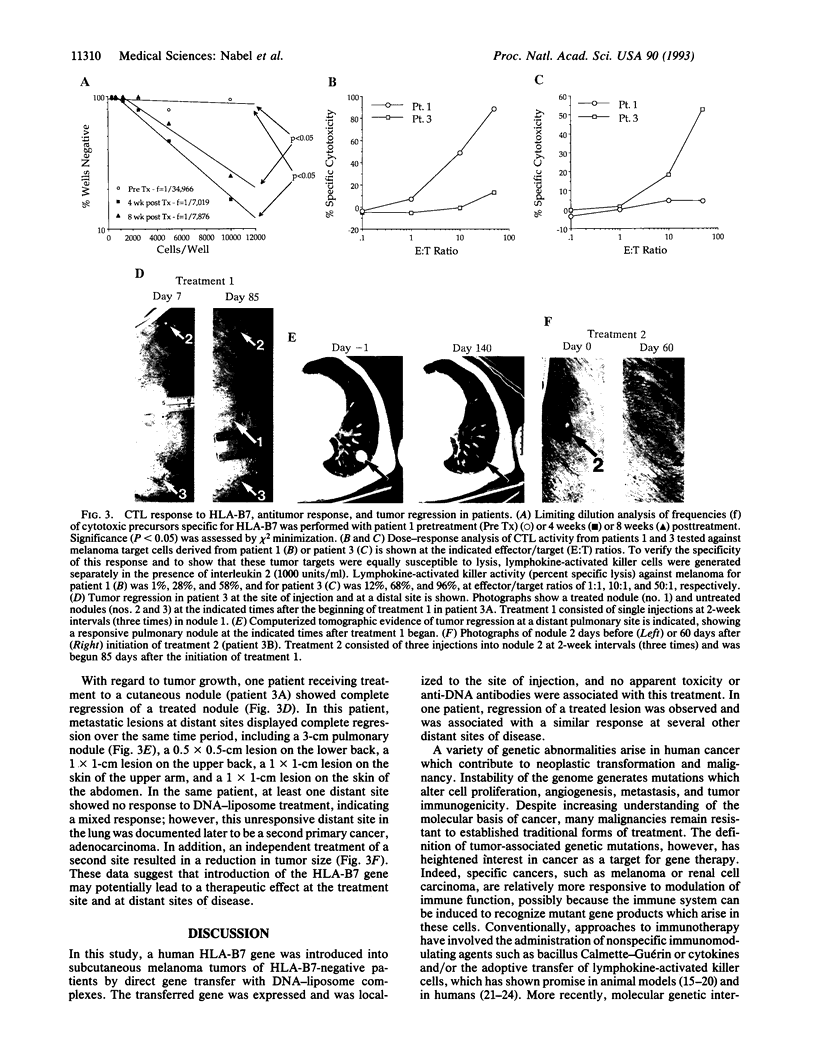
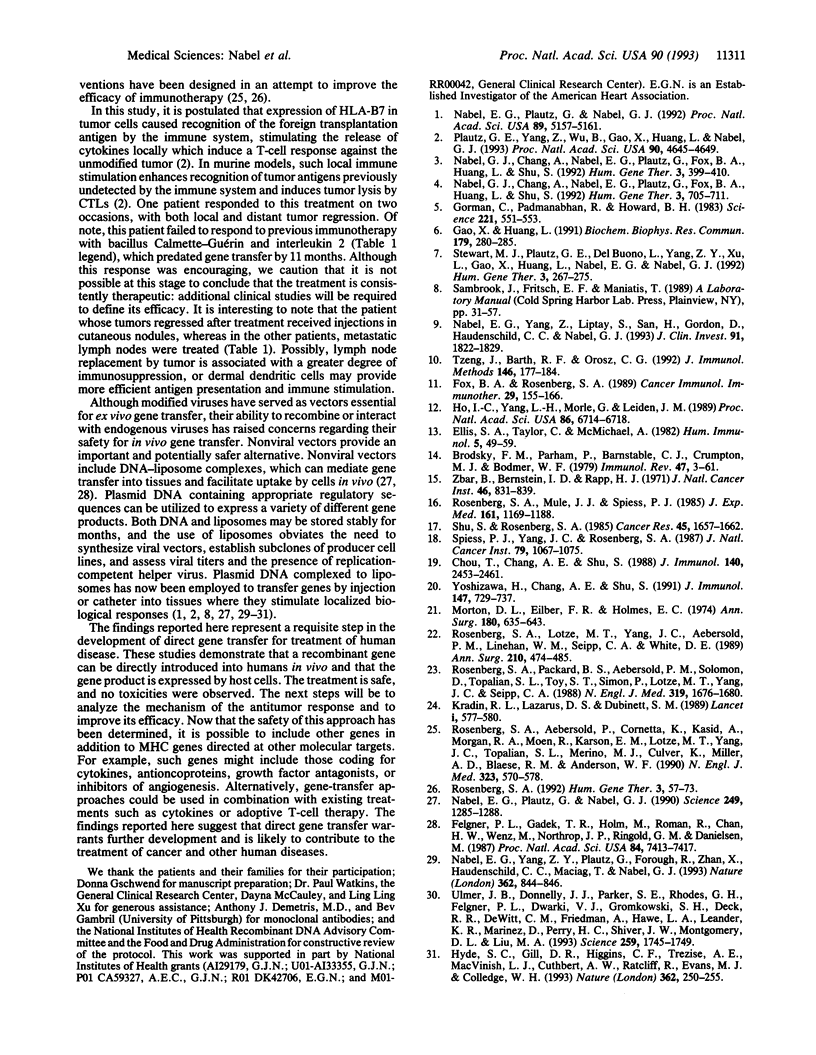
Images in this article
Selected References
These references are in PubMed. This may not be the complete list of references from this article.
- Brodsky F. M., Parham P., Barnstable C. J., Crumpton M. J., Bodmer W. F. Monoclonal antibodies for analysis of the HLA system. Immunol Rev. 1979;47:3–61. doi: 10.1111/j.1600-065x.1979.tb00288.x. [DOI] [PubMed] [Google Scholar]
- Chou T., Chang A. E., Shu S. Y. Generation of therapeutic T lymphocytes from tumor-bearing mice by in vitro sensitization. Culture requirements and characterization of immunologic specificity. J Immunol. 1988 Apr 1;140(7):2453–2461. [PubMed] [Google Scholar]
- Ellis S. A., Taylor C., McMichael A. Recognition of HLA-B27 and related antigen by a monoclonal antibody. Hum Immunol. 1982 Aug;5(1):49–59. doi: 10.1016/0198-8859(82)90030-1. [DOI] [PubMed] [Google Scholar]
- Felgner P. L., Gadek T. R., Holm M., Roman R., Chan H. W., Wenz M., Northrop J. P., Ringold G. M., Danielsen M. Lipofection: a highly efficient, lipid-mediated DNA-transfection procedure. Proc Natl Acad Sci U S A. 1987 Nov;84(21):7413–7417. doi: 10.1073/pnas.84.21.7413. [DOI] [PMC free article] [PubMed] [Google Scholar]
- Fox B. A., Rosenberg S. A. Heterogeneous lymphokine-activated killer cell precursor populations. Development of a monoclonal antibody that separates two populations of precursors with distinct culture requirements and separate target-recognition repertoires. Cancer Immunol Immunother. 1989;29(3):155–166. doi: 10.1007/BF00199990. [DOI] [PMC free article] [PubMed] [Google Scholar]
- Gao X., Huang L. A novel cationic liposome reagent for efficient transfection of mammalian cells. Biochem Biophys Res Commun. 1991 Aug 30;179(1):280–285. doi: 10.1016/0006-291x(91)91366-k. [DOI] [PubMed] [Google Scholar]
- Gorman C., Padmanabhan R., Howard B. H. High efficiency DNA-mediated transformation of primate cells. Science. 1983 Aug 5;221(4610):551–553. doi: 10.1126/science.6306768. [DOI] [PubMed] [Google Scholar]
- Ho I. C., Yang L. H., Morle G., Leiden J. M. A T-cell-specific transcriptional enhancer element 3' of C alpha in the human T-cell receptor alpha locus. Proc Natl Acad Sci U S A. 1989 Sep;86(17):6714–6718. doi: 10.1073/pnas.86.17.6714. [DOI] [PMC free article] [PubMed] [Google Scholar]
- Hyde S. C., Gill D. R., Higgins C. F., Trezise A. E., MacVinish L. J., Cuthbert A. W., Ratcliff R., Evans M. J., Colledge W. H. Correction of the ion transport defect in cystic fibrosis transgenic mice by gene therapy. Nature. 1993 Mar 18;362(6417):250–255. doi: 10.1038/362250a0. [DOI] [PubMed] [Google Scholar]
- Immunization of cancer patients using autologous cancer cells modified by insertion of the gene for tumor necrosis factor. Hum Gene Ther. 1992 Feb;3(1):57–73. doi: 10.1089/hum.1992.3.1-57. [DOI] [PubMed] [Google Scholar]
- Immunotherapy of malignancy by in vivo gene transfer into tumors. Hum Gene Ther. 1992 Aug;3(4):399–410. doi: 10.1089/hum.1992.3.4-399. [DOI] [PubMed] [Google Scholar]
- Kradin R. L., Kurnick J. T., Lazarus D. S., Preffer F. I., Dubinett S. M., Pinto C. E., Gifford J., Davidson E., Grove B., Callahan R. J. Tumour-infiltrating lymphocytes and interleukin-2 in treatment of advanced cancer. Lancet. 1989 Mar 18;1(8638):577–580. doi: 10.1016/s0140-6736(89)91609-7. [DOI] [PubMed] [Google Scholar]
- Morton D. L., Eilber F. R., Holmes E. C., Hunt J. S., Ketcham A. S., Silverstein M. J., Sparks F. C. BCG immunotherapy of malignant melanoma: summary of a seven-year experience. Ann Surg. 1974 Oct;180(4):635–643. doi: 10.1097/00000658-197410000-00029. [DOI] [PMC free article] [PubMed] [Google Scholar]
- Nabel E. G., Plautz G., Nabel G. J. Site-specific gene expression in vivo by direct gene transfer into the arterial wall. Science. 1990 Sep 14;249(4974):1285–1288. doi: 10.1126/science.2119055. [DOI] [PubMed] [Google Scholar]
- Nabel E. G., Plautz G., Nabel G. J. Transduction of a foreign histocompatibility gene into the arterial wall induces vasculitis. Proc Natl Acad Sci U S A. 1992 Jun 1;89(11):5157–5161. doi: 10.1073/pnas.89.11.5157. [DOI] [PMC free article] [PubMed] [Google Scholar]
- Nabel E. G., Yang Z. Y., Plautz G., Forough R., Zhan X., Haudenschild C. C., Maciag T., Nabel G. J. Recombinant fibroblast growth factor-1 promotes intimal hyperplasia and angiogenesis in arteries in vivo. Nature. 1993 Apr 29;362(6423):844–846. doi: 10.1038/362844a0. [DOI] [PubMed] [Google Scholar]
- Nabel E. G., Yang Z., Liptay S., San H., Gordon D., Haudenschild C. C., Nabel G. J. Recombinant platelet-derived growth factor B gene expression in porcine arteries induce intimal hyperplasia in vivo. J Clin Invest. 1993 Apr;91(4):1822–1829. doi: 10.1172/JCI116394. [DOI] [PMC free article] [PubMed] [Google Scholar]
- Plautz G. E., Yang Z. Y., Wu B. Y., Gao X., Huang L., Nabel G. J. Immunotherapy of malignancy by in vivo gene transfer into tumors. Proc Natl Acad Sci U S A. 1993 May 15;90(10):4645–4649. doi: 10.1073/pnas.90.10.4645. [DOI] [PMC free article] [PubMed] [Google Scholar]
- Response to the points to consider for immunotherapy of malignancy by in vivo gene transfer into tumors. Hum Gene Ther. 1992 Dec;3(6):705–711. doi: 10.1089/hum.1992.3.6-705. [DOI] [PubMed] [Google Scholar]
- Rosenberg S. A., Aebersold P., Cornetta K., Kasid A., Morgan R. A., Moen R., Karson E. M., Lotze M. T., Yang J. C., Topalian S. L. Gene transfer into humans--immunotherapy of patients with advanced melanoma, using tumor-infiltrating lymphocytes modified by retroviral gene transduction. N Engl J Med. 1990 Aug 30;323(9):570–578. doi: 10.1056/NEJM199008303230904. [DOI] [PubMed] [Google Scholar]
- Rosenberg S. A., Lotze M. T., Yang J. C., Aebersold P. M., Linehan W. M., Seipp C. A., White D. E. Experience with the use of high-dose interleukin-2 in the treatment of 652 cancer patients. Ann Surg. 1989 Oct;210(4):474–485. doi: 10.1097/00000658-198910000-00008. [DOI] [PMC free article] [PubMed] [Google Scholar]
- Rosenberg S. A., Mulé J. J., Spiess P. J., Reichert C. M., Schwarz S. L. Regression of established pulmonary metastases and subcutaneous tumor mediated by the systemic administration of high-dose recombinant interleukin 2. J Exp Med. 1985 May 1;161(5):1169–1188. doi: 10.1084/jem.161.5.1169. [DOI] [PMC free article] [PubMed] [Google Scholar]
- Rosenberg S. A., Packard B. S., Aebersold P. M., Solomon D., Topalian S. L., Toy S. T., Simon P., Lotze M. T., Yang J. C., Seipp C. A. Use of tumor-infiltrating lymphocytes and interleukin-2 in the immunotherapy of patients with metastatic melanoma. A preliminary report. N Engl J Med. 1988 Dec 22;319(25):1676–1680. doi: 10.1056/NEJM198812223192527. [DOI] [PubMed] [Google Scholar]
- Shu S. Y., Rosenberg S. A. Adoptive immunotherapy of newly induced murine sarcomas. Cancer Res. 1985 Apr;45(4):1657–1662. [PubMed] [Google Scholar]
- Spiess P. J., Yang J. C., Rosenberg S. A. In vivo antitumor activity of tumor-infiltrating lymphocytes expanded in recombinant interleukin-2. J Natl Cancer Inst. 1987 Nov;79(5):1067–1075. [PubMed] [Google Scholar]
- Stewart M. J., Plautz G. E., Del Buono L., Yang Z. Y., Xu L., Gao X., Huang L., Nabel E. G., Nabel G. J. Gene transfer in vivo with DNA-liposome complexes: safety and acute toxicity in mice. Hum Gene Ther. 1992 Jun;3(3):267–275. doi: 10.1089/hum.1992.3.3-267. [DOI] [PubMed] [Google Scholar]
- Tzeng J. J., Barth R. F., Orosz C. G. Quantitation of glioma-reactive cytolytic T lymphocyte precursors by means of limiting dilution analysis. J Immunol Methods. 1992 Feb 5;146(2):177–184. doi: 10.1016/0022-1759(92)90226-j. [DOI] [PubMed] [Google Scholar]
- Ulmer J. B., Donnelly J. J., Parker S. E., Rhodes G. H., Felgner P. L., Dwarki V. J., Gromkowski S. H., Deck R. R., DeWitt C. M., Friedman A. Heterologous protection against influenza by injection of DNA encoding a viral protein. Science. 1993 Mar 19;259(5102):1745–1749. doi: 10.1126/science.8456302. [DOI] [PubMed] [Google Scholar]
- Yoshizawa H., Chang A. E., Shu S. Specific adoptive immunotherapy mediated by tumor-draining lymph node cells sequentially activated with anti-CD3 and IL-2. J Immunol. 1991 Jul 15;147(2):729–737. [PubMed] [Google Scholar]
- Zbar B., Bernstein I. D., Rapp H. J. Suppression of tumor growth at the site of infection with living Bacillus Calmette-Guérin. J Natl Cancer Inst. 1971 Apr;46(4):831–839. [PubMed] [Google Scholar]





